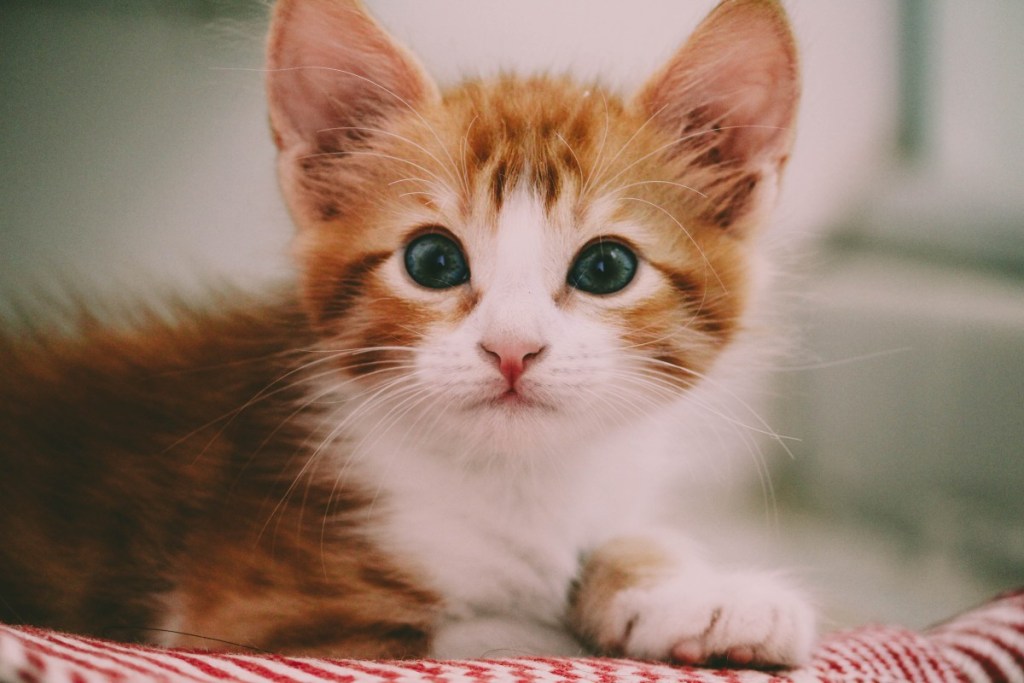Kittens and human babies aren’t as different as you might think. Sure, one comes out looking like a raisin and the other is a ball of fur, but there are several similarities. They’re both adorable (yes, even the raisin). They’re dependent and need you to introduce them to the world or at least your home. Kittens and newborns are warm and cuddly. They’re a ton of work, but it’s so worth it.
There’s at least one more similarity: They usually have blue eyes when they are born.
You could probably stare into your kitty’s piercing, beautiful baby blues forever. It’s so much fun to watch their eyes light up as they get used to their surroundings and discover new things about the world, from birds chirping to a favorite toy.
Why do kittens have blue eyes, though? We looked into it for you.

Why do kittens have blue eyes?
Ultimately, eye color comes down to melanin. What’s that? Melanin is the pigment that affects the color of a human’s skin, hair, and eyes. In our kitty’s case, it helps determine their fur and eye color. Melanocytes (special skin cells) make melanin. More melanocytes increase the melanin levels in a cat’s eyes. These cats will ultimately have a darker eye color, such as copper.
If a cat is over six weeks old and still has blue eyes, that means they don’t have melanocytes or pigment in their eyes. Don’t worry about a very young kitten that is four to six weeks old, though. These babies have blue eyes because their melanocytes aren’t functioning just yet. They will as the furball progress through kittenhood.
When to expect a kitten’s eye color to change
Melanocytes usually start to work when your kitten is about 4 to 6 weeks old, give or take a week or two. Many cat parents won’t ever see their kitten with blue eyes. You will if you are fostering or caring for very young kittens, though.
The process does take a while. You may start to notice tiny brown, yellow, green, amber, or orange spots in your kitten’s eyes when they are one to two months old. It may look a little strange, but it’s perfectly normal and means their eyes are changing color right before your very eyes (and right on schedule).
Your kitten’s eyes will likely have transformed into their adult color by the time your kitten is 3 to 4 months of age.

What happens if a kitten’s eyes stay blue (or change back to blue)?
If your kitten’s eyes don’t change, it’s likely not cause for concern. Some breeds, like Siamese cats and Himalayan Persians, have blue eyes forever. It’s always a good idea to ask your veterinarian about the lack of change, though, just in case there’s another issue at play.
Sometimes, only one eye changes color while the other stays blue. This condition is known as heterochromia iridis, and it happens when one eye doesn’t have any pigment. It’s usually not a red flag, and it’s more common in felines with white coats.
What is cause for concern? If your cat’s eyes change colors and then revert back to blue, that can be a sign of vision impairment, including blindness. You’ll want to book an appointment with your cat’s vet to get their eyes checked if you notice this happening.
Another eye color change that warrants a vet visit is if your pet’s eyes — blue or otherwise — turn pink or red. That’s a sign of conjunctivitis, which is treatable but painful for your cat. You’ll want to squash it fast.
More about cats’ eyes
Our cats use their eyes to tell us they love us (or are annoyed with us). Though some of their other senses (like smell) are more powerful, they do still see the world in part through their eyes. Why do kittens have blue eyes at birth? It’s because special skin cells, known as melanocytes, haven’t started working yet. When they do, they’ll produce the melanin that typically changes a kitten’s eye color. Unless you meet your kitten very early in life — when they’re four to six weeks old — you may never know them with blue eyes. After that time, a kitten’s eyes will start to change colors. Some breeds, such as Siamese cats, keep their blue eyes forever. That’s normal. Sometimes, cats will have one blue eye, but the other will change. This condition is also usually not concerning, but you should speak with your vet just in case.
Editors' Recommendations
- Are ‘dog years’ really 7 human years? How to calculate your dog’s age
- Is your dog barking nonstop? Here’s how to get your noisy pup under control
- Do puppies sleep a lot? These are the perfectly normal sleeping habits of a healthy pup
- Pet-safe pest control: This genius technique will get rid of pesky ants
- When do kittens’ eyes change colors? The answer is so cool – here’s what to know




